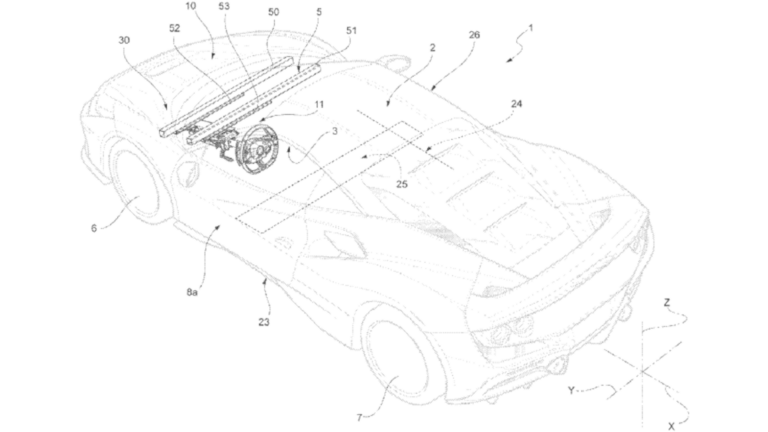Ferrari, the iconic Italian manufacturer of sports cars, supercars, and grand tourers, is synonymous with performance and innovation. Founded by Enzo Ferrari in 1939, the company has a storied history rooted in motorsport, with a legacy of success in Formula 1 and endurance racing like Le Mans. Ferrari’s commitment to pushing the boundaries of automotive technology is evident in its pursuit of new features and mechanical advancements. Here’s a look at 10 recent patents that could shape future Ferrari models, offering a glimpse into the brand’s technological ambitions.
1. Customizable Driving Position

One of the most intriguing concepts involves a fully customizable interior layout, allowing drivers to switch between left-hand drive (LHD), right-hand drive (RHD), and even a central driving position. This innovation could provide drivers with the flexibility to adapt to different driving environments, such as changing sides of the road during international travel or using a central driving position on a track. The primary challenge lies in connecting the pedals to the engine components while allowing for movement. Ferrari’s potential solution is to implement wire controls for steering, acceleration, braking, and even the clutch in a manual transmission model. By using this approach, the steering wheel and pedal box remain mobile, providing drivers with a flexible and adaptable driving experience.
2. Upside-Down Engine
Ferrari, while embracing electrification, is also exploring alternative fuel technologies, particularly hydrogen. A notable patent features an “upside-down” engine layout where the turbocharger draws energy from the crankshaft. This design provides additional space for hydrogen tanks and related components. The company has also filed a similar patent using a supercharger instead of a turbocharger. Though the first patent specifically mentioned hydrogen powertrains, the second one did not. However, we have reason to suspect that both were created with a hydrogen-powered vehicle in mind.
3. Rotating Infotainment Display

Inspired by the rotating display in the Lotus Esprit from the James Bond film The Spy Who Loved Me, Ferrari’s rotating infotainment screen patent aims to seamlessly integrate the technology into the dashboard’s aesthetic. This design allows the infotainment system to blend into the dashboard, providing multiple functions without occupying too much space, similar to Bentley’s system.
4. Aerodynamically Optimized Hydrogen Fuel Cell Layout
Ferrari’s exploration of hydrogen-powered vehicles extends beyond the engine. Another patent reveals a new layout for a hydrogen fuel cell stack designed to optimize aerodynamics and maintain the dynamic character of mid-engine vehicles. The proposed design keeps the vehicle’s center of gravity low and central, ensuring the driving characteristics customers expect from a mid-engine Ferrari will be maintained in a hydrogen-powered model. The fuel cell itself will function as an aero device.
5. Street-Legal Four-Point Harnesses

Ferrari has been working to overcome the drawbacks of racing harnesses for road use. Their patent reveals a design for road-legal four-point harnesses designed to mitigate some of these issues. These harnesses use disintegrating seams that reveal folded lengths of belt. This allows movement of the chest and neck, which helps to prevent whiplash.
6. Intelligent Exhaust System

Auditory feedback is a crucial element of the Ferrari driving experience. The company’s “intelligent” exhaust adjusts the sound profile based on the driving mode. Additionally, it functions aerodynamically via incrementally adjustable flaps at the exhaust pipe exits. These flaps alter exhaust gas flow, influencing vehicle performance at high speeds. This exhaust system is optimized for front-engine, RWD, V8-powered sports cars.
7. Torque-Vectoring Steering Wheel

Borrowing technology from Formula 1, this innovative steering wheel offers unprecedented control over torque distribution to individual wheels in EV models or by use of a torque-vectoring differential in internal combustion cars. This functionality can be toggled with buttons, based on driver skill and preference. The wheel’s design also echoes single-seat racing wheels.
8. Two EV Auditory Feedback Systems

Ferrari is developing not one, but two distinct auditory feedback systems for its electric vehicles. The first system amplifies sounds produced by electric motors using resonance tubes. The second uses “aerophone instruments” (similar to a pipe organ) installed under the car to channel airflow and create sound. Both rely on acoustics, without the need for speakers or electronic devices.
9. Infinitely Adjustable Seats

Recognizing the importance of driver comfort, Ferrari has patented a new seating technology offering nearly infinite adjustability for the optimal seating position. The seat is divided into seven sections, each with a wide range of movement. A camera scans the occupant’s posture and automatically adjusts the seat to achieve maximum comfort, eliminating the need for numerous manual levers.
10. Joystick Steering

While steering wheel replacements are often met with skepticism, Ferrari is exploring the replacement of the steering wheel with a joystick. The company’s move is intended to enhance driver comfort over extended journeys, rather than to facilitate autonomous driving. The joystick design offers an alternative layout to enhance the driving experience and overall comfort.



